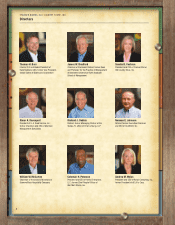Cracker Barrel 2014 Annual Report Download - page 20
Download and view the complete annual report
Please find page 20 of the 2014 Cracker Barrel annual report below. You can navigate through the pages in the report by either clicking on the pages listed below, or by using the keyword search tool below to find specific information within the annual report.
accounted for a 0.2% decrease in restaurant cost of goods sold
as a percentage of restaurant revenue.
We presently expect the rate of commodity ination to be
approximately 4% to 5% in 2015 as compared to 2014.
We expect to partially oset the eects of food commodity
ination through a combination of menu price increases,
supply contracts and other cost reduction initiatives.
e following table highlights retail cost of goods sold as a
percentage of retail revenue for the past three years:
2014 2013 2012
Retail Cost of Goods Sold 51.9% 52.4% 52.1%
e decrease in retail cost of goods sold as a percentage
of retail revenue in 2014 as compared to 2013 resulted
primarily from lower freight, higher initial markup on retail
merchandise, lower shrinkage and a reduction in the
obsolescence inventory reserve partially oset by higher
markdowns.
2013 to 2014
(Decrease) Increase as a
Percentage of Total Revenue
Freight (0.4%)
Higher initial markup on merchandise (0.2%)
Retail inventory shrinkage (0.1%)
Obsolescence inventory reserve (0.1%)
Markdowns 0.4%
e increase in retail cost of goods sold as a percentage of
retail revenue in 2013 as compared to 2012 resulted from
lower initial markup on retail merchandise partially oset by
lower freight and shrinkage.
2012 to 2013
Increase (Decrease) as a
Percentage of Total Revenue
Lower initial markup on merchandise 0.6%
Freight (0.2%)
Retail inventory shrinkage (0.1%)
Labor and Related Expenses
Labor and other related expenses include all direct and
indirect labor and related costs incurred in store operations.
e following table highlights labor and other related expenses
as a percentage of total revenue for the past three years:
2014 2013 2012
Labor and other related expenses 36.0% 36.5% 36.8%
e year-to-year percentage change from 2013 to 2014
resulted from the following:
2013 to 2014
(Decrease) as a Percentage
of Total Revenue
Store bonus expense (0.3%)
Employee health care expenses (0.1%)
Store hourly labor (0.1%)
Lower store bonus expense in 2014 as compared to
2013 reected lower performance against nancial objectives
in 2014 as compared to the prior year.
e decrease in our employee health care expenses as
compared to the prior year is primarily the result of the
reimbursement of approximately $4,700 for certain health
care premiums related to the plan year ending December 31,
2013 partially oset by higher enrollment and higher net
premium costs related to the plan year ending December 31,
2014. During 2014, we recorded a receivable of $6,200
for reimbursement of certain health care premiums related to
the plan year ending December 31, 2014 of which $3,600
reduced employee health care expenses in 2014. We presently
expect to record an additional reimbursement of approxi-
mately $2,000 to $4,000 in 2015 related to the plan year ending
December 31, 2014.
e decrease in store hourly labor costs as a percentage
of total revenue from 2013 to 2014 resulted from menu price
increases being higher than wage ination and improved
productivity.
e year-to-year percentage change from 2012 to 2013
resulted from the following:
2012 to 2013
(Decrease) Increase as a
Percentage of Total Revenue
Store hourly labor (0.5%)
Store bonus expense 0.2%
e decrease in store hourly labor costs as a percentage
of total revenue from 2012 to 2013 resulted from menu price
increases being higher than wage ination and improved
productivity. Higher store bonus expense in 2013 as compared
to 2012 reected beer performance against nancial
objectives in 2013 as compared to the prior year.
18
























